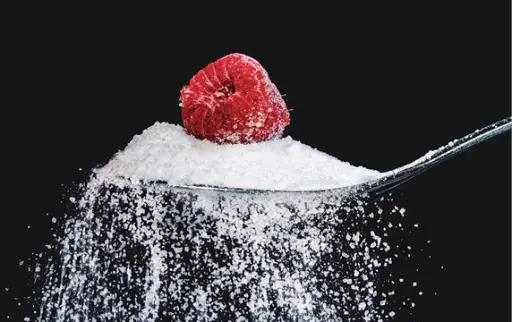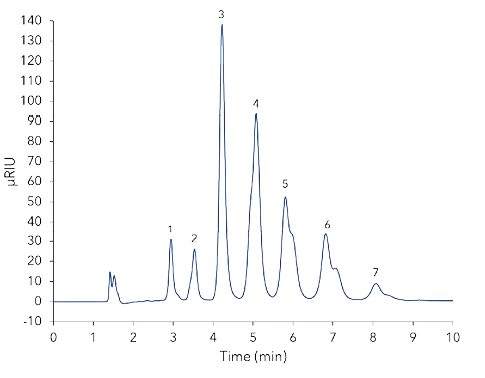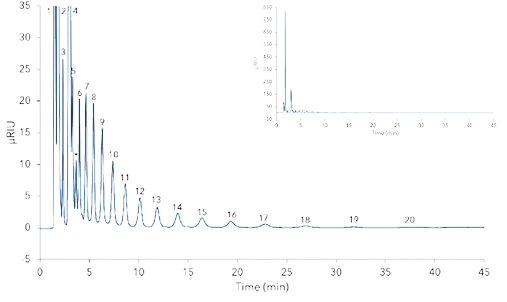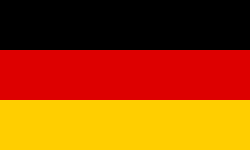
Science with Passion
Application No.: VTN0009 Version 1 06/2020
HILIC – Sugars and fructooligosaccharide analysis
Juliane Böttcher, Kate Monks; applications@knauer.net
KNAUER Wissenschaftliche Geräte GmbH, Hegauer Weg 38, 14163 Berlin
Marcel Hoevels, Franziska Wienberg
Universität Bonn, AG Prof. Dr. Deppenmeier, Institut für Mikrobiologie und Biotechnologie (IfMB)

Summary
The determination of carbohydrates can sometimes be challenging. Not all columns are able to separate monomers, dimers, and oligomers at the same time. The KNAUER Eurospher II Amino (NH2) phase applied in hydrophilic interaction liquid chromatography (HILIC) mode can solve this task. Even carbohydrates with a high degree of polymerization (DP) can be separated.
Introduction
Sugar or carbohydrate analysis is often performed using polymer columns or special stationary phases with ligand exchange and/or size exclusion mechanism. But the run time of those measurements can be very long, depending on the degree of polymerization (DP) that should be analysed. The use of NH2 columns allows faster methods and takes advantage of completely different interactions between analyte and stationary phase. Amino bonded silica gel phases can be used ideally in the normal phase and hydrophilic interaction liquid chromatography (HILIC) mode. They show alternative normal phase selectivity to unbonded silica, especially for aromatics. Amino columns can also be used in the HILIC mode for carbohydrate analysis and for other polar compounds. Typically, the amino group is bonded to the silica support via a propyl linker and the phases are often non endcapped (Fig. 1). HILIC is a technique that uses a polar stationary phase in conjunction with a mobile phase containing an appreciable quantity of water combined with a higher proportion of a less polar solvent (often acetonitrile). Most commonly, separations are carried out using 5 to 40% water (or aqueous buffers)[1]. HILIC provides an alternative approach to effectively separate small polar compounds on polar stationary phases.

Fig. 1 Abstracted illustration of a bonded amino group to silica.
Results
The detailed method parameters are described in the material and methods section. The shown data and method were recorded and provided by the group of Prof. Dr. Uwe Deppenmeier from the Institute for Microbiology and Biotechnology (IfMB), University of Bonn [2]. Samples with different complexity were measured, from low degree of polymerization up to DP17. Fig. 2 shows a sugar and inulin-type fructooligosaccharide (FOS) standard at a concentration of 2.50 mM for each compound. The isocratic separation is achieved in under eight minutes. Except for glucose and sucrose, all peaks are baseline separated and can be quantified if requested.

Fig. 2 Chromatogram of sugar and inulin-type FOS standard, 2.50 mM. 1 - injection peak, 2 - glucose, 3 - sucrose, 4 - 1-kestose, 5 - 1,1-kestotetraose, 6 - 1,1,1-kestopentaose.
Fig. 3 shows a sample of FOS from chicory with DP2 to DP7. The sample concentration was 50 mM.

Fig. 3 Chromatogram of FOS from chicory, 50 mM. 1 - fructose, 2 - DP2, 3 - DP3, 4 - DP4, 5 - DP5, 6 - DP6, 7 - DP7.
Furthermore, inulin-type FOS samples generated by bacterial inulosucrase were determined. The goal is to transfer the raw material (sucrose) almost completely (> 90%) and then interrupt the reaction. The duration of the synthesis is dependent on the amount of used protein and sucrose2. The measured samples were taken at three different times of the process: after 0.5 hours, 1 hour and 6 hours. The following figures display the original chromatograms (right top corner) and an enhanced view of the same measurement to illustrate the smaller peaks of the substances with a high DP. Fig. 4 shows the sample after 0.5 hours of the FOS generation process. Peak four has a little shoulder at about 2.95 minutes, which is fructose.

Fig. 4 FOS generated from bacterial inulosucrase after 0.5 hours. 1 - injection peak, 2 - sample matrix, 3 - glycerol, 4 - glucose, 5 - sucrose, 6 - DP3, 7 - DP4, 8 - DP5, 9 - DP6, 10 - DP7, 11 - DP8.
Fig. 5 and Fig. 6 show the sample after 1 and 6 hours of the FOS generation process. Within half an hour of the enzymatic reaction carbohydrates up to DP9 where produced, compared to Fig. 4. Between peak five and six a small peak is visible. This is an unidentified substance occurring in the synthesis process (Fig. 5). Also, an intermediate sample was measured after 4 hours but there was no significant difference to the sample after 6 hours (Fig. 6).

FOS generated from bacterial inulosucrase after 1 hour. 1 - injection peak, 2 - sample matrix, 3 - glycerol, 4 - glucose, 5 - sucrose, 6 - DP3, 7 - DP4, 8 - DP5, 9 - DP6, 10 - DP7, 11 - DP8, 12 - DP9, * - unidentified substance.

FOS generated from bacterial inulosucrase after 6 hours. 1 - injection peak, 2 - sample matrix, 3 - glycerol, 4 - fructose/glucose, 5 - sucrose, , 6 - DP3, 7 - DP4, 8 - DP5, 9 - DP6, 10 - DP7, 11 - DP8, 12 - DP9, 13 - DP10, 14 - DP11, 15 - DP12, 16 - DP13, 17 - DP14, 18 - DP15, 19 - DP16, 20 - DP17, * - unidentified substance.
Sample Preparations
The concentration of the analytes in standards and samples lay in a range from 0.2 up to 50 mM. The samples/standards were diluted with acetonitrile:water mixtures. Dependent on the eluent used in the method, it was tried to keep the acetonitrile concentration as near as possible to the starting conditions of the method[2].
Conclusion
The benefits of carbohydrate analysis with amino stationary phase in HILIC mode clearly lies in the run time. The KNAUER Eurospher II NH2 stationary phase achieves an outstanding separation for the fructooligosaccharide samples as well as for samples with lower DPs. Therefore it is perfectly suited for this type of analysis. In about 15 minutes it is possible to determine complex samples with a degree of polymerization up to DP11 (Fig. 6). By extending the run time even the analysis of samples with DP17 or more is possible.
Materials and Methods
Tab. 1 Method parameters
Column temperature | 40 °C |
Injection volume | 20 µl |
Injection mode | Partial loop |
Detection | Refractive index |
Data rate | 20 Hz |
Tab. 2 Pump parameters
Eluent (A) | Acetonitrile:water 60:40 (v/v) |
Flow rate | 0.6 ml/min |
Gradient | Isocratic |
Tab. 3 System configuration
Instrument | Description | Article No. |
Pump | Thermo SpectraSYSTEM P4000 | - |
Degasser | Thermo SpectraSYSTEM SCM1000 | - |
Autosampler | Thermo SpectraSYSTEM AS3000 | - |
Detector | Shodex RI-101 | - |
Thermostat | N/A | - |
Column | Eurospher II 100-5 NH2, 250 x 3 mm ID with precolumn |
References
[1] McCalley, D. V. Hydrophilic interaction chromatography. http://www.chromatographyonline.com/hydrophilic-interaction-chromatography-0 (2008).
University of Bonn, Group of Prof. Dr. Uwe Deppenmeier, Institute for Microbiology and Biotechnology (IfMB).
Related KNAUER Applications
VFD0105J – Separation of fructooligosaccharides
VFD0120J – Separation of maltooligosaccharides by HILIC
VFD0161 – Determination of sugar in honey using HILIC separation and RI detection
Application details
|
Method |
HPLC |
|
Mode |
HILIC |
|
Substances |
glucose, sucrose, 1-kestose, glycerol, 1,1-kestotetraose, 1,1,1-kestopentaose, carbohydrates from DP3 to DP17 |
|
CAS number |
n/a |
|
Version |
Application No.: VTN0009 | Version 1 06/2020 | ©KNAUER Wissenschaftliche Geräte GmbH |


